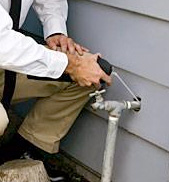Are Silent Destroyers Invading Your Home?
How to Prevent Termite Damage
Termite workers and soldiers are blind, but they have a keen sense of smell, which enables them to hone in on your home as they sniff out the cellulose they crave within the wood. And because they’re cryptobiotic (that means their activity is hidden from view) termites can do a lot of damage before you even know they’ve moved in.
House fires, hurricanes and floods may get all the headlines, but termites are a much bigger threat to your home than any of these disasters. According to the National Pest Management Association, termites cost American homeowners more than $5 billion a year! Experts believe termites have been around for 250 million years, so it’s unlikely they will be leaving us any time soon. But there are some things you can do to keep your home from becoming their next meal.
Deprive them of what they need the most.
Termites require four basic things to make them happy: food, moisture, shelter and optimal temperature. So here are some ways you can make your home less attractive to them:
- Seal the cracks and gaps around your home’s foundation, attic vents and eaves
- Remove any foam insulation or wood that touches the ground around your home
- Keep shrubbery and landscaping at least six inches away from your home
- Do not stack firewood or lumber near your home’s foundation
Watch for the signs that they’re settling in.
- Knock on wood and listen for a hollow sound, which could mean termite damage
- Cracking or malformed paint can indicate there are termites underneath
- Termites build mud tubes up foundations and exterior walls as they search for food
- Look for swarms of flying termites nearby or their discarded wings
- Regularly inspect fences and decks for signs of damage
- Look for fecal pellets or droppings, called “frass”
Termites are too destructive and your home is too valuable for you to take any unnecessary chances. If you suspect you have termites – or if you don’t trust your termite detection skills – call a professional and set up a termite management plan!




